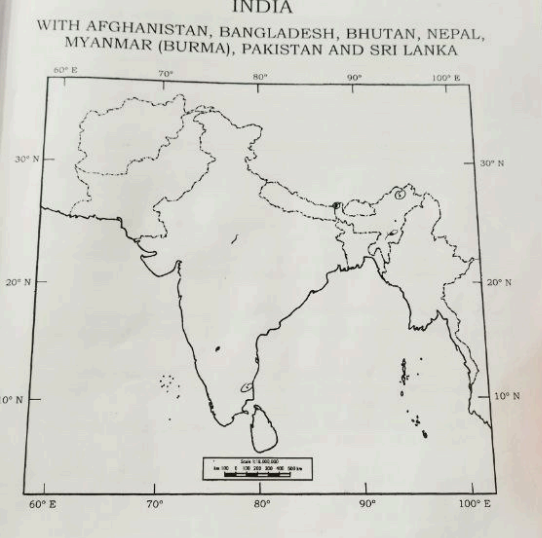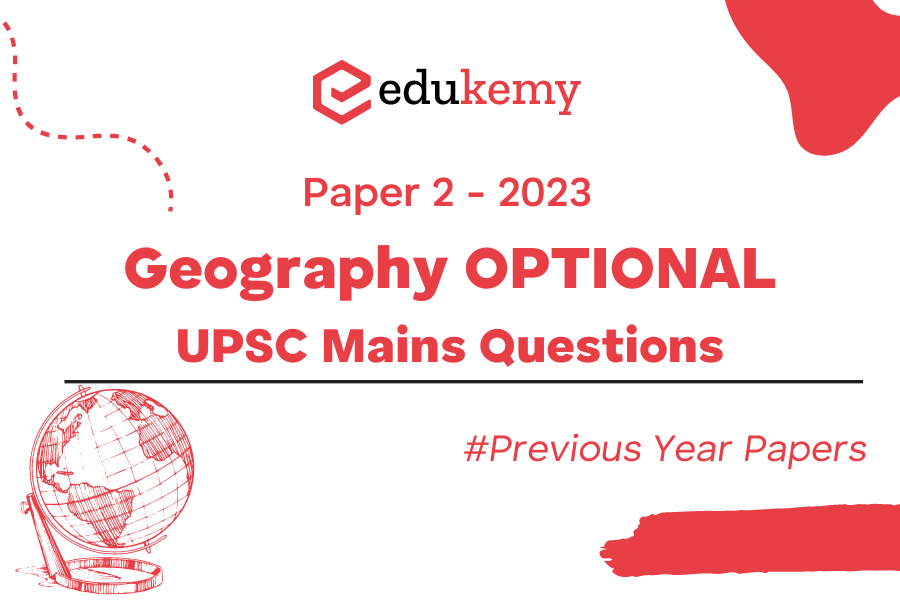
The UPSC Mains Geography Optional Question Paper 2 for the year 2023 is a critical assessment tool that challenges candidates’ understanding and analytical skills in the realm of geography. As an integral component of the Civil Services Examination conducted by the Union Public Service Commission (UPSC), this paper seeks to evaluate the depth of knowledge and the ability of aspirants to synthesize information on a diverse array of geographical topics. With a focus on both theoretical concepts and practical applications, Question Paper 2 delves into various facets of physical, human, and regional geography, demanding a nuanced understanding of geographical phenomena and their interconnectedness. This examination not only tests candidates’ theoretical acumen but also assesses their capacity to apply geographical principles to real-world scenarios, ensuring that successful candidates possess a well-rounded and comprehensive grasp of the subject.
Contents
- 1 Geography Optional Question Paper-1 (2023)
- 1.1 SECTION A
- 1.2 SECTION B
- 1.3 Download UPSC Mains Geography Question Paper 2 – 2023 PDF Here
- 1.4 Frequently Asked Questions (FAQs)
- 1.4.1 Question: Discuss the role of geomorphology in understanding the Earth’s surface processes and landforms.
- 1.4.2 Question: Assess the impact of climate change on global water resources and elucidate strategies for sustainable water management.
- 1.4.3 Question: Analyze the role of regional planning in promoting balanced regional development in the context of India.
प्रश्न-पत्र सम्बन्धी विशेष अनुदेश
- कृपया प्रश्नों के उत्तर देने से पूर्व निम्नलिखित प्रत्येक अनुदेश को ध्यानपूर्वक पढ़ें । इसमें आठ प्रश्न हैं जो दो खण्डों में विभाजित हैं तथा हिन्दी एवं अंग्रेजी दोनों में छपे हुए हैं । उम्मीदवार को कुल पाँच प्रश्नों के उत्तर देने हैं ।
- प्रश्न संख्या 1 और 5 अनिवार्य हैं तथा बाकी प्रश्नों में से प्रत्येक खण्ड से कम-से-कम एक प्रश्न चुनकर तीन
- प्रश्नों के उत्तर दीजिए ।
- प्रत्येक प्रश्न / भाग के लिए नियत अंक उसके सामने सूचित हैं ।
- प्रश्नों के उत्तर उसी प्राधिकृत माध्यम में लिखे जाने चाहिए, जिसका उल्लेख आपके प्रवेश पत्र में किया गया है, – और इस माध्यम का स्पष्ट उल्लेख प्रश्न- सह उत्तर (क्यू.सी.ए.) पुस्तिका के मुखपृष्ठ पर निर्दिष्ट स्थान पर किया जाना चाहिए । प्राधिकृत माध्यम के अतिरिक्त अन्य किसी माध्यम में लिखे गए उत्तर पर कोई अंक नहीं मिलेंगे । प्रश्नों में शब्द सीमा, जहाँ विनिर्दिष्ट है, का अनुसरण किया जाना चाहिए ।
- जहाँ आवश्यक हो, अपने उत्तरों को उपयुक्त चित्रों / मानचित्रों तथा आरेखों द्वारा दर्शाइए। इन्हें प्रश्न का उत्तर देने के लिए दिए गए स्थान में ही बनाना है।
- प्रश्नों के उत्तरों की गणना क्रमानुसार की जाएगी। आंशिक रूप से दिए गए प्रश्नों के उत्तर को भी मान्यता दी जाएगी यदि उसे काटा न गया हो। प्रश्न- सह उत्तर पुस्तिका में खाली छोड़े गए कोई पृष्ठ अथवा पृष्ठ के भाग को पूर्णतः काट दीजिए ।
Question Paper Specific Instructions
- Please read each of the following instructions carefully before attempting questions :
- There are EIGHT questions divided in two SECTIONS and printed both in HINDI and in ENGLISH.
- Candidate has to attempt FIVE questions in all.
- Questions no. 1 and 5 are compulsory and out of the remaining, THREE are to be attempted choosing at least ONE from each section.
- The number of marks carried by a question / part is indicated against it.
- Answers must be written in the medium authorized in the Admission Certificate which must be stated clearly on the cover of this Question-cum-Answer (QCA) Booklet in the space provided. No marks will be given for answers written in a medium other than the authorized one.
- Word limit in questions, wherever specified, should be adhered to.
- Illustrate your answers with suitable sketches, maps and diagrams. These shall be drawn in the space provided for answering the question itself.
- Attempts of questions shall be counted in chronological order. Unless struck off, attempt of a question shall be counted even if attempted partly. Any page or portion of the page left blank in the answer book must be clearly struck off.

Geography Optional Question Paper-1 (2023)
SECTION A
1.(a) आपको दिए गए भारत के रेखा पर निम्नलिखित सभी की स्थिति को अंकित कीजिए। अपना क्यू० सी० ए० पुस्तिका में इन स्थानों में से प्रत्येक का भौतिक/ वाणिज्यिक / आर्थिक/पारिस्थितिक/ पर्यावरणीय सांस्कृतिक महत्त्व अधिकतम 30 शब्दों में लिखिए:
On the outline map of India provided to you, mark the location of all of the following. Write in your QCA Booklet the significance of these locations, whether physical/commercial/economic/ecological/environmental/cultural, in not more than 30 words for each entry: 2*10 = 20
- नाला Nathula
- हट्टी Hutti
- रॉस द्वीप Ross Island
- मोरेह Moreh
- रामप्पा Ramappa
- रामा राष्ट्रीय उद्यान Namdapha National Park
- सेला सुरंग Sela Tunnel
- एन्नोर बंदरगाह Ennore Port
- रामागुंडम Ramagundam
- बेतवा नदी Betwa River

1.(b) भारत में गोंडवाना प्रणाली की चट्टानों की उत्पत्ति, वितरण और आर्थिक महत्त्व का वर्णन कीजिए।
Describe the origin, distribution and economic significance of Gondwana system of rocks in India. 10
1.(c) मौसम पूर्वानुमान और आपदा प्रबंधन को बढ़ाने में भारतीय पृथ्वी अवलोकन उपग्रह प्रौद्योगिकी की भूमिका का परिक्षण करें।
Examine the role of Indian Earth Observation Satellite Technology in enhancing weather forecasting and disaster management. 10
1. (d) भारत में वन संरक्षण पर राष्ट्रीय हरित अधिकरण अधिनियम, 2010 के प्रभाव की विवेचना किजिये। Discuss the impact of the National Green Tribunal Act, 2010 on forest conservation in India. 10
2. (a) भारत के महानगरीय क्षेत्रों में ठोस अपशिष्ट के कारण उत्पन्न पर्यावरणीय चुनौतियों का परीक्षण कीजिए और इस पर काबू पाने के प्रयासों की विवेचना कीजिए।
Examine the environmental challenges caused by the solid waste in metropolitan regions of India and discuss the efforts to overcome it. 20
2. (b) मोटे अनाज को ‘पोषक अनाज’ और जलवायु लचीला भी माना जाता है? भारत में मोटे अनाज की खेती की बाधाओं और (सु) अवसरों की विवेचना कीजिए।
Why are millets considered as nutri-cereals’ and climate-resilient? Discuss the constraints and opportunities of millet cultivation in India. 15
2. (c) भारतीय द्वीपों के भू-रणनीतिक महत्व का परीक्षण कीजिए। Examine the geostrategic significance of Indian islands. 15
3. (a) भारतीय औषधीय उद्योग को वैश्विक बाजार पर कब्जा करने के लिए ‘मात्रा’ से लेकर ‘मूल्य’ नेतृत्व तक आगे बहना होगा। विवेचना कीजिए।
Indian Pharma Industry has to move from volume’ to ‘value’ leadership to capture global market. Discuss. 20
3. (c) भारत के विशेष संदर्भ में अंतर्राष्ट्रीय भू-राजनीति पर पेट्रोलियम ऊर्जा संसाधनों की भूमिका का समालोचनात्मक परीक्षण कीजिए।
Critically examine the role of petroleum energy resources on International Geopolitics with special reference to India. 15
4. (a) गिरती प्रजनन दर और बढ़ती औसत आयु के साथ, भारत जनसांख्यिकीय लाभांश को आर्थिक लाभांश में बदल सकता है?
With falling fertility rate and rising median age, how can India translate demographic dividend to economic dividend? 20
4. (b) भारत में शहरी नियोजन की खराब गुणवत्ता शहरीकरण की वास्तविक आर्थिक क्षमता को साकार करने में एक बड़ी बाधा है। समालोचनात्मक परीक्षण कीजिए।
Poor quality of urban planning in India is a huge constraint in realizing the true economic potentials of urbanization. Critically examine. 15
4. (c) भारत की व्यापार नीति की प्रमुख विशेषताओं को चिह्नांकित कीजिए। चीन के साथ भारत के व्यापार संतुलन की स्थिति की विवेचना कीजिए।
Highlight the salient features of India’s trade policy. Discuss the status of India’s balance of trade with China. 15

SECTION B
5. निम्नलिखित में से प्रत्येक प्रश्न का उत्तर लगभग 150 शब्दों में दीजिए: Answer the following questions in about 150 words each: 10×5-50
5. (a) भारत में जूट उत्पादक क्षेत्रों की पहचान कीजिए तथा जूट मिल उद्योग में गिरावट के प्रमुख कारणों की विवेचना -कीजिए।
Identify the jute-producing areas and discuss the major causes of decline of jute mill industry in India.
5. (b) भारत के बड़े शहरों में शहरी निर्मित वातावरण भू-दृश्य के जैव भौतिकीय चरित्र में मुख्य परिवर्तन पैदा करता है। विवेचना कीजिए।
Urban built environment in big cities of India creates key changes in biophysical character of the landscape. Discuss.
5. (c) पूर्वी घाटों की भूवैज्ञानिक विशेषताओं और पारिस्थितिक महत्त्व की व्याख्या कीजिए।
Explain the geological characteristics and ecological significance of the Eastern Ghats.
5. (e) आर्थिक विकास और राष्ट्रीय सुरक्षा के लिए क्रांतिक खर क्यों आवश्यक है?
Why are critical minerals essential for the economic development and national security in India?
6. (a) बड़ी संख्या में भारतीय शहरों में उनके ऐतिहासिक विकास के कारण जटिल रूपात्मक विशेषताएं होती है। स्पष्ट कीजिए।
A large number of Indian cities have a complex morphological characteristics due to their historical evolution. Elucidate. 20
6. (b) भारत में सतत कृषि विकास के लिए जैविक खेती के महत्व की विवेचना कीजिए।
Discuss the significance of organic farming for sustainable agricultural development in India. 15
8. (a) भारत कृषि उत्पादकता में कई अन्य देशों से पीछे क्यों है? सभी क्षेत्रों में टिकाऊ तरीके से उत्पादकता बढ़ाने के लिए उपयुक्त उपाय सुझाइए।
Why India lags behind many other countries in agricultural productivity? Suggest suitable measures to raise productivity across the regions in a sustainable manner. 20
8. (b) अण्डमान और निकोबार द्वीपसमूह एवं लक्षद्वीप की पारिस्थितिकी पर्यटन क्षमता का आकलन कीजिए और द्वीप क्षेत्रों के सतत विकास से जुड़ी चुनौतियों पर प्रकाश डालिए।
Assess the ecotourism potential of Andaman and Nicobar, Lakshadweep islands and highlight the challenges associated with the sustainable development of island territories. 15

Download UPSC Mains Geography Question Paper 2 – 2023 PDF Here
Frequently Asked Questions (FAQs)
Question: Discuss the role of geomorphology in understanding the Earth’s surface processes and landforms.
Answer: Geomorphology, a crucial sub-discipline of geography, focuses on the study of the Earth’s surface processes and landforms. It plays a pivotal role in unraveling the dynamic forces shaping the landscape. Through detailed analyses of landforms and their origins, geomorphology aids in comprehending the intricate interplay of factors such as tectonics, weathering, erosion, and deposition. By investigating features like mountains, valleys, and coastal formations, geomorphologists contribute to our understanding of both past and present geological processes, providing valuable insights for environmental management and hazard mitigation.
Question: Assess the impact of climate change on global water resources and elucidate strategies for sustainable water management.
Answer: Climate change poses a significant threat to global water resources, affecting both quantity and quality. Altered precipitation patterns, melting glaciers, and changing runoff dynamics contribute to shifts in water availability. Increased frequency of extreme weather events exacerbates water-related challenges. To ensure sustainable water management, it is imperative to adopt an integrated approach. This involves implementing efficient water conservation measures, investing in technology for water purification, promoting watershed management, and formulating policies that prioritize equitable water distribution. International collaboration and community participation are essential components of a comprehensive strategy to address the complex implications of climate change on global water resources.
Question: Analyze the role of regional planning in promoting balanced regional development in the context of India.
Answer: Regional planning plays a vital role in fostering balanced development across different regions of India. By addressing spatial disparities in economic, social, and infrastructural aspects, regional planning aims to reduce regional imbalances. It involves the identification of regional strengths and weaknesses, formulation of policies to capitalize on local resources, and strategic investments to promote inclusive growth. Effective regional planning should consider factors such as population distribution, resource endowment, and connectivity. Through the creation of regional development plans, policymakers can channel resources strategically, stimulate economic activities, and enhance the overall well-being of diverse regions, contributing to a more balanced and sustainable national development agenda.
In case you still have your doubts, contact us on 9811333901.
For UPSC Prelims Resources, Click here
For Daily Updates and Study Material:
Join our Telegram Channel – Edukemy for IAS
- 1. Learn through Videos – here
- 2. Be Exam Ready by Practicing Daily MCQs – here
- 3. Daily Newsletter – Get all your Current Affairs Covered – here
- 4. Mains Answer Writing Practice – here
Visit our YouTube Channel – here

